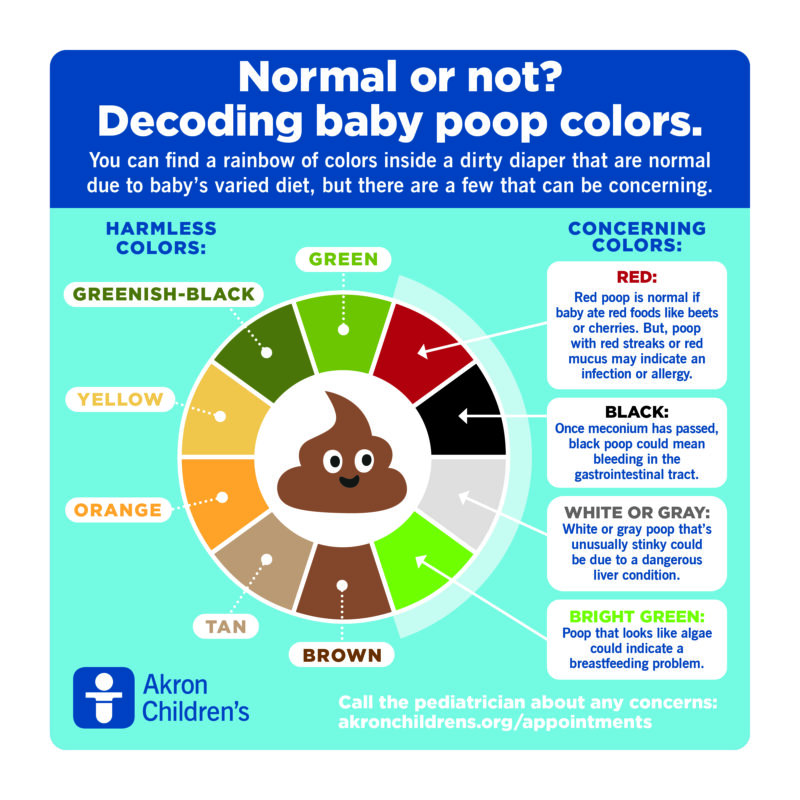 From insufficient nutrition to allergies and infections, so much about a baby’s health can be learned from inside a dirty diaper. It offers a wealth of information, but many moms find themselves spending too much time and energy analyzing their babies’ poop colors.
From insufficient nutrition to allergies and infections, so much about a baby’s health can be learned from inside a dirty diaper. It offers a wealth of information, but many moms find themselves spending too much time and energy analyzing their babies’ poop colors.
Well, moms can let out a big sigh of relief because most poop colors are normal.
“Most of the time poop will change color based on the baby’s diet, as well as the things a mother’s eating or supplements she’s taking,” said Dr. Sarah Adams, a pediatrician at Akron Children’s Pediatrics, Hudson. “A baby’s bowel movements can change quickly, and variations in color and consistency are normal. Don’t be surprised if it is yellow yesterday and green today!”
Whether a baby is breast-fed or formula-fed, stools can vary in color greatly and still be considered normal. But while mothers can find a rainbow of colors inside a baby’s diaper that are normal, there are a few that can be a call for concern. Dr. Adams breaks down poop colors to help parents decode which ones are harmless and when to call the pediatrician.
Harmless baby poop colors
- Green: Green or dark green poop is almost always harmless. It is most likely due to food or dyes in food either from breast milk or food itself, or certain medications mom is taking, such as an iron supplement.
- Greenish-black: Once meconium, baby’s first poop during the first few days of life, begins to pass, a baby’s poop may turn greenish-black and that’s a good indication the breast milk or formula is being properly digested.
- Yellow or orange: Yellow or mustard-yellow poop is typical for a breastfed baby. It also may have seed-like pieces and be very runny.
- Tan: Tan poop is typical of a formula-fed baby. It may also appear the same color as peanut butter, yellow-brown or greenish-brown and is usually stinkier than breast milk poop.
- Brown: Brown is the most common poop color for a baby eating solids or weaning off breast milk or formula.
Concerning baby poop colors
- Red: Red poop can be harmless if baby swallowed blood from nipples while feeding, for example, or ate red foods, such as tomatoes, beets or cherries. However, if you see red streaks in poop that is pebbly and dry, it could mean baby is constipated or there’s bleeding in the lower gastrointestinal tract. Red streaks in poop could also indicate diaper rash or an allergy. Contact your pediatrician.
- Raspberry red: If you notice blood in your baby’s poop that is streaked with red mucus, like dark raspberry jelly, contact your pediatrician immediately. It could be a sign of an infection or allergy.
- Black: During the first few days of life, a baby’s meconium poop can be black and is no cause for concern. However, once meconium has passed, a black poop could be caused by bleeding in the upper gastrointestinal tract and requires medical attention.
- White or gray: If your baby’s poop is pale white or clay-colored and unusually stinky, it could be a sign of a rare, but dangerous liver condition. Call your pediatrician right away.
- Bright green: A breast milk imbalance can cause your baby’s poop to appear bright green, almost like algae. This can indicate your baby is getting too much foremilk, which comes at the beginning of feeding and is thinner and lower in fat. Your baby may need more time at each breast to get the hind milk, or richer, fattier milk.
So after analyzing a baby’s dirty diaper, how can parents tell whether a color is caused by food or something more serious?
“The No. 1 thing is if the child looks ill and isn’t acting right or eating well, contact your pediatrician,” said Dr. Adams. “If it changes with just one bowel movement and resolves, usually there’s nothing to worry about. If the abnormal color can’t be explained by any particular foods or medications and it’s persisting for more than a day, then we’d want to see the child.”
If you’re concerned about your baby’s bowel movements, schedule an appointment with one of our pediatricians.











